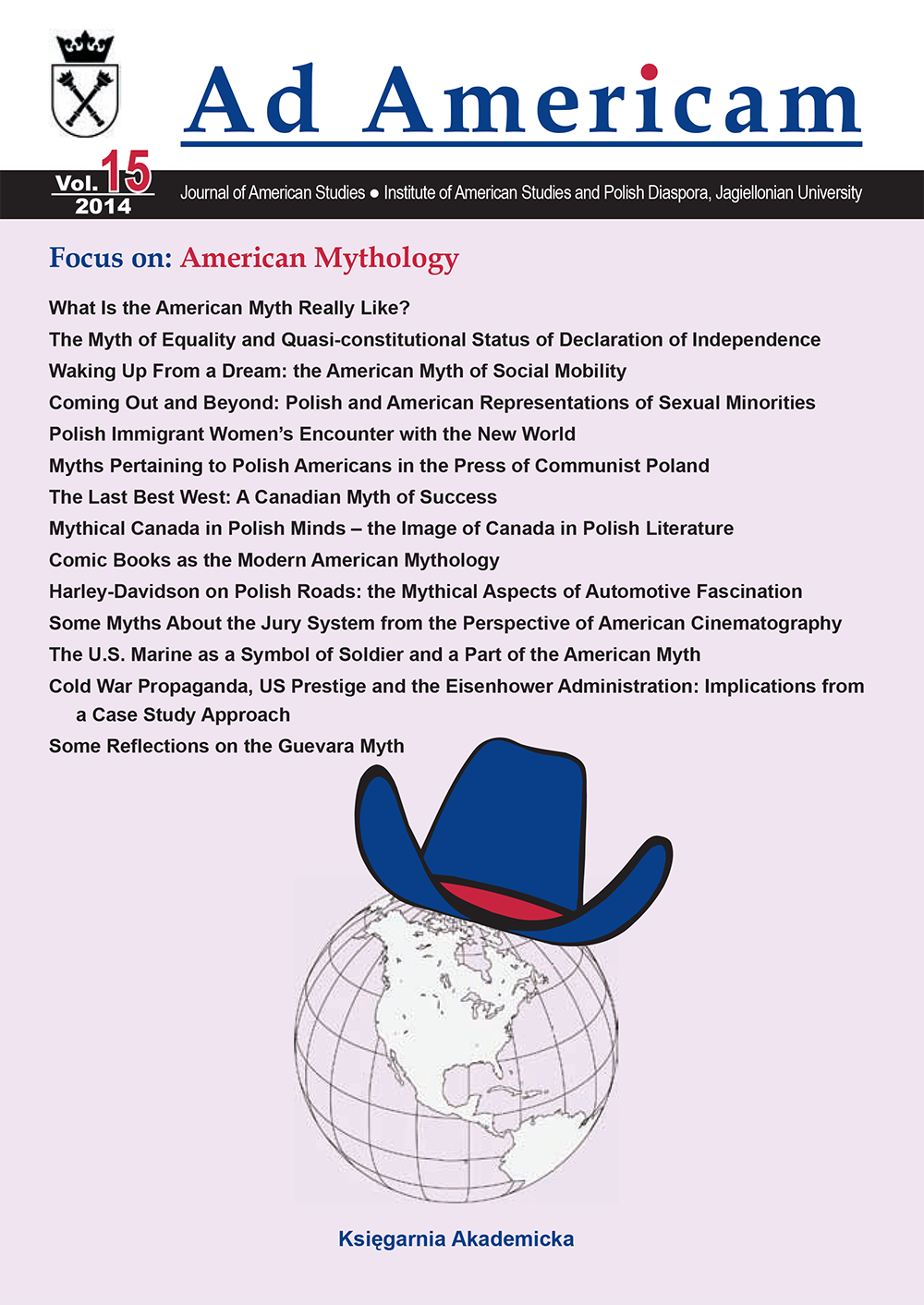What Is the American Myth Really Like?
DOI:
https://doi.org/10.12797/AdAmericam.15.2014.15.02Abstract
This article sets out to establish the main characteristics of the American Myth. The phenomenon is defined here as “the sum of views, visions, images, values, beliefs and opinions presenting the United States as a positive country, and Americans, as a people, in a good light.” The article also addresses the concept (after W. Blum) of the American Nightmare or American Demon that encompasses all the opposites of the positive connotations of the term American Myth.
The main questions posed here are: How is it possible that the culture, civilization and society of a relatively young country can currently shape and effectively influence the world to such an extent? Why not an older and more “esteemed” civilization and culture? The author tries to establish the impact that “Americanness” has had on the rest of the world. The main elements of the American Myth seem to be: the promise of a better “something,” wealth in the American way, the American mythical millionaire, optimism and individualism, success the American way, remoteness and distance, modernity and progress, freedom and democracy and – finally – a supportive attitude towards war and violence. The paper attempts an analysis and evaluation of these from the perspective of cultural and political studies.
Myth is not a lie. A myth is a story, compounded of fact and fiction, which expresses something fundamental about the worldview and the values of the people who tell it: what they assume about how the world is and how people should and do live in it. The people who tell a myth do not judge it by whether it can be proven factually true. Rather, it shapes their view of truth; it tells them what they can accept as factually true and what they must consider false. A mythic story can be told explicitly, or it can be merely implied by a few brief words or an image or action. Either way, a myth evokes powerful emotions because it expresses something essential about the identity of the group and its members, as they see it (Chernus).
References
“The other American Dream.” The Economist, Nov 24th 2012. Web. 23 October 2014, http://www.economist.com/news/special‑report/21566779‑border‑traffic‑isnt‑all‑one‑way‑other‑american‑dream.
Baudrillard, Jean. Ameryka. Tłum. Renata Lis, Warszawa: Wydawnictwo Sic!, 1998.
Berezowski, Maksymilian. Krótka encyklopedia USA. Warszawa: DW Elipsa, 2001.
Blum, William. Rogue State: a Guide to the World’s Only Superpower. New York: Common Courage Press, 2000. DOI: https://doi.org/10.5040/9781350251175
Bryson, Bill. Zapiski z wielkiego kraju. Tłum. Dagmara Chojnacka, Warszawa: Zysk i S‑ka, 2001.
Brzeziński, Zbigniew. Wybór: dominacja czy przywództwo. Kraków: Znak, 2004.
Carnegie, Dale. How to Win Friends and Influence People. New York: Simon and Schuster, 1936.
Chernus, Ira. Mythic America. Web. 14 September 2013. http://mythicamerica.wordpress.com/about‑mythic‑america.
Domosławski, Artur. Ameryka zbuntowana: siedemnaście dialogów o ciemnych stronach imperium wolności. Warszawa: Świat Książki, 2007.
Garrison, Jim. Ameryka jako imperium: przywódca świata czy bandycka potęga. Warszawa: Von Borowiecky, 2005.
Himmelfarb, Gertrude. Jeden naród, dwie kultury. Warszawa: Wydawnictwa Akademickie i Profesjonalne, 2007.
Huntington, Samuel. Kim jesteśmy: wyzwania dla amerykańskiej tożsamości narodowej. Tłum. Bartłomiej Pietrzyk, Kraków: Znak, 2007.
Kagan, Robert, Potęga i raj: Ameryka i Europa w nowym porządku świata. Warszawa: Studia Emka, 2003.
Kaiser‑Lechowicz, Anna. “Poleganie na samym sobie: indywidualizm i demokracja amerykańska.” Amerykańska demokracja w XXI wieku. Ed. Paweł Laidler. Kraków: Wydawnictwo UJ, 2006: 245‑252.
Kozłowski, Sławomir Grzegorz. Współczesna Ameryka: mity i rzeczywistość. Lublin: Wydawnictwo UMCS, 2001.
Lexington. “The American Dream, RIP?” The Economist. Web. 24 October 2014, http://www.economist.com/news/united‑states/21586581‑economist‑asks‑provocative‑questions‑about‑future‑social‑mobility‑american.
Lubowski, Andrzej. Kontuzjowane mocarstwo: siła i słabość Ameryki. Warszawa: Świat Książki, 2007.
Łysiak, Waldemar. Asfaltowy saloon. Warszawa: Nobilis, 2005.
Michałek, Krzysztof (red.). Konstytucja oraz inne podstawowe dokumenty i symbole amerykańskiej kultury patriotycznej. Warszawa: Mada, 2005.
Petry‑Mroczkowska, Joanna. Amerykańska wojna kultur. Warszawa: Biblioteka “Więzi”, 1999.
Sardar, Ziauddin, and Merryl Wyn Davies. Dlaczego ludzie nienawidzą Ameryki. Kraków: Post, 2004.
Sorman, Guy. Made in America: spojrzenie na cywilizację amerykańską. Warszawa: Prószyński i S‑ka, 2005.
Soros, George. Bańka amerykańskiej supremacji. Tłum. Dominika Chylińska, Kraków: Znak, 2004.
Surdykowski, Jerzy. Dokąd zmierza Ameryka, czyli drugie czytanie Tocqueville’a. Warszawa: Politeja, 2001.
Szymkowska‑Bartyzel, Jolanta. Amerykański mit – polski konsument, czyli reklamowe oblicza Ameryki. Kraków: Wydawnictwo UJ, 2006.
Tocqueville de, Alexis. Democracy in America. London: Penguin, 2001.
Woods Jr., Thomas. Niepoprawna politycznie historia Stanów Zjednoczonych. Tłum. Marcin Zieliński, Warszawa: Fijor Publishing, 2004.
Zinn, Howard. A People’s History of the United States, 1942‑Present. New York: HarperCollins, 1995.
Downloads
Published
Issue
Section
License
Copyright (c) 2014 Mateusz Bogdanowicz

This work is licensed under a Creative Commons Attribution-NonCommercial-NoDerivatives 4.0 International License.






